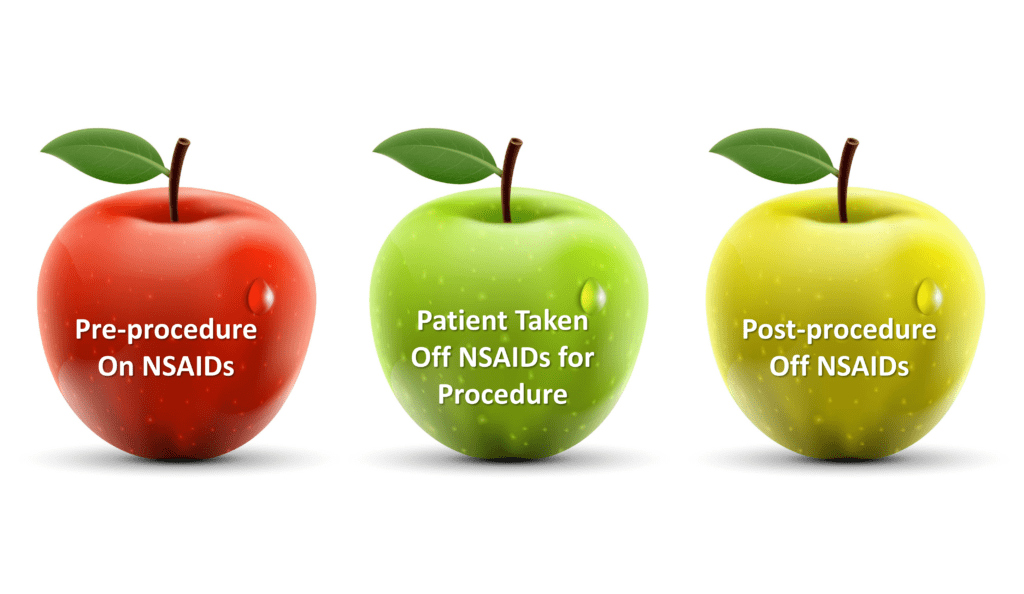The NSAID Apples to Apples Dilemma

Credit: Shutterstock
One of the things we often do to help patient outcomes before, during, and after a regenerative medicine procedure is to restrict certain medications we know can hurt healing or the cells we’re using. One of the more common things we do is to take patients off NSAID drugs. However, that often creates a conundrum in comparing outcomes from before and after the procedure. Let’s dig in.
What Is an NSAID?
NSAID stands for Non-Steroidal Anti-inflammatory Drug. You know this drug class by the commonly used NSAIDs you can find in the grocery or drug store that go by names like Motrin, Advil, and Aleve. They act by inhibiting an inflammatory pathway called cyclooxygenase (COX) and thus reducing inflammation. Other drugs in this class include Voltaren, Celebrex, and others.
These medications are commonly given to patients with chronic pain. While they can help inflammation, they have a host of known side effects including GI bleeding and elevating heart attack and stroke risk (1).
How Do NSAIDs Impact Regenerative Medicine Procedures?
I’ve blogged on several studies through the years that show that NSAIDs don’t mix well with procedures involving mesenchymal stem cells. For example, Aleve (Naprosyn) was shown to cause MSCs to make bad cartilage (2). Voltaren caused MSCs to turn into fat cells instead of tendon cells (3). We also know that NSAIDs in general block bone healing by messing with the local progenitor cells and growth factor release (4,5).
Restricting NSAIDs in BMC and PRP Procedures
Because we’re often treating things like cartilage, tendons, ligaments, and bone in these regenerative medicine procedures, we don’t want NSAIDs interfering with this process. Hence, we restrict patients from taking these medications for usually 6 weeks before, during, and after the procedure. However, that restriction can also cause its own set of issues.
NSAID “Addiction”
While NSAIDs aren’t addictive in the same way that narcotics can be, many patients have learned through the years that these over-the-counter drugs can reduce pain and help them function better. Many end up needing them just to function every day. Hence, when we take patients off of these drugs before a regenerative medicine procedure, they naturally go backward in function, meaning that the pre-procedure baseline is more disabled than usual. After the regen med procedure, there are a few possible outcomes:
A. The procedure helped enough so that the patient no longer needs NSAIDs
B. The procedure helped, but that the patient is not yet able to ditch NSAIDs
C. The procedure fails
Situation A is easy to figure out. However, deciding if B or C happened takes a little experience.
The NSAID Test
Every once in a while I find myself in the place where we’re trying to figure out if a first procedure helped or not. This is often the case when it’s expected that multiple procedures will be needed. If the patient was reliant on NSAIDs before the procedure, we use the “NSAID Test”. This means getting them back on the same dose and frequency of NSAID after the procedure. Generally, a week trial works. Why? This is an apples-to-apples comparison to see if the patient notices less pain and more function as a result of the procedure. If so, then we know we’re on the right track and that an additional procedure is advised.
The upshot? Deciding whether a patient improved after a regenerative medicine procedure can sometimes take a little experience. If the patient was “addicted” to NSAIDs before the procedure and needed them to function, restarting those drugs for a short time after the procedure may well determine if the patient successfully responded.
_____________________________________
References:
(1) Wongrakpanich S, Wongrakpanich A, Melhado K, Rangaswami J. A Comprehensive Review of Non-Steroidal Anti-Inflammatory Drug Use in The Elderly. Aging Dis. 2018;9(1):143-150. Published 2018 Feb 1. doi:10.14336/AD.2017.0306
(2) Alaseem AM, Madiraju P, Aldebeyan SA, Noorwali H, Antoniou J, Mwale F. Naproxen induces type X collagen expression in human bone-marrow-derived mesenchymal stem cells through the upregulation of 5-lipoxygenase. Tissue Eng Part A. 2015 Jan;21(1-2):234-45. doi: 10.1089/ten.TEA.2014.0148. Epub 2014 Oct 23. PMID: 25091567; PMCID: PMC4292866.
(3) Fredriksson M, Li Y, Stålman A, Haldosén LA, Felländer-Tsai L. Diclofenac and triamcinolone acetonide impair tenocytic differentiation and promote adipocytic differentiation of mesenchymal stem cells. J Orthop Surg Res. 2013 Sep 2;8:30. doi: 10.1186/1749-799X-8-30. PMID: 24004657; PMCID: PMC3766711.
(4) Su B, O’Connor JP. NSAID therapy effects on healing of bone, tendon, and the enthesis. J Appl Physiol (1985). 2013;115(6):892-899. doi:10.1152/japplphysiol.00053.2013
(5) Pountos I, Panteli M, Walters G, Giannoudis PV. NSAIDs inhibit bone healing through the downregulation of TGF-β3 expression during endochondral ossification. Injury. 2021 Jun;52(6):1294-1299. doi: 10.1016/j.injury.2021.01.007. Epub 2021 Jan 10. PMID: 33472741.

NOTE: This blog post provides general information to help the reader better understand regenerative medicine, musculoskeletal health, and related subjects. All content provided in this blog, website, or any linked materials, including text, graphics, images, patient profiles, outcomes, and information, are not intended and should not be considered or used as a substitute for medical advice, diagnosis, or treatment. Please always consult with a professional and certified healthcare provider to discuss if a treatment is right for you.
